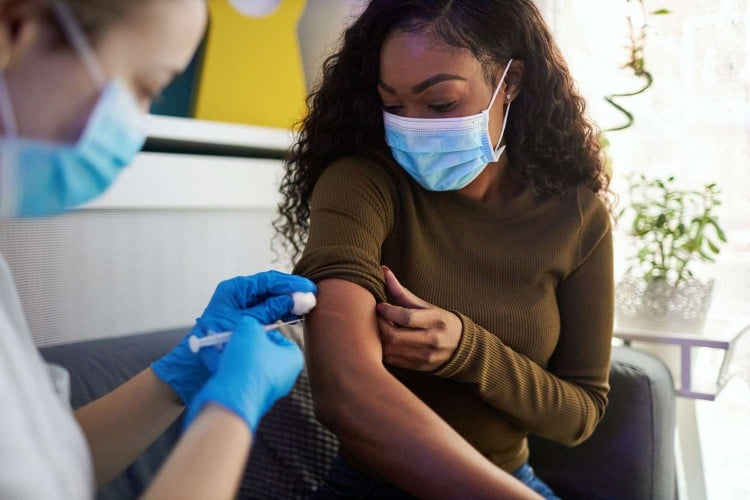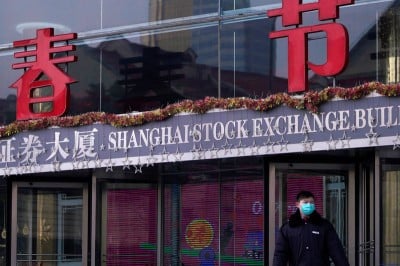How Do Vaccines Affect the Economy?

vgajic/Getty Images
Vaccine programs are an investment in a country’s human capital. They improve public health, life expectancy, and work performance. Vaccines can also reduce government spending on disease treatment and control. Without a vaccine, new diseases can become widespread because immunity may take longer to develop.
In March 2020, the COVID-19 pandemic launched an economic crisis unprecedented in speed and ferocity. To stop the spread of the disease, most countries ordered nonessential businesses to shut down. As a result, workers were laid off and demand plummeted. The U.S. economy contracted a record 31.4% in the second quarter. Gross domestic product (GDP) had never fallen more than 10% in any quarter since the government began tracking it in 1947.
The U.S. shutdown triggered the stock market crash of 2020. It began on March 9, with history’s largest point plunge for the Dow Jones Industrial Average (DJIA) up to that date. On March 11, the Dow fell 20.3% from its prior high on Feb. 12, which launched a bear market and ended the 11-year bull market that started in March 2009. Two more record-setting point plunges followed, on March 12 and March 16. The Dow finally hit its low for the year on March 23. The stock market crash included the three worst point drops ever recorded.
Note
The 2020 recession ended the longest economic expansion in U.S. history.
Economists quickly warned that the economy needed widely distributed vaccines for the economy to return to normal. Business consultant McKinsey & Company estimated in December 2020 that such an effort would cost more than $10 billion, but the economic benefits would be “orders of magnitude higher.”
How News About COVID-19 Vaccines Has Affected the Market
On Nov. 9, 2020, Pfizer announced that its COVID-19 vaccine was more than 90% effective in a phase 3 study; later that month, Pfizer raised the effectiveness level to 95%. The company expected to produce 50 million vaccines in 2020 and 1.3 billion in 2021. Each person requires two doses of the vaccine, spaced several weeks apart, to receive full protection.
On Nov. 16, 2020, Moderna announced that its coronavirus vaccine was 94.5% effective. The company’s market capitalization tripled as its stock price soared following the news. Moderna developed the vaccine with $483 million in federal funds. Ironically, the company has never before brought a successful drug to market.
The stock market responded to the news of pending vaccinations by setting record highs. The same day Moderna announced the news, the Dow closed at 29,950.44. On Nov. 24, the stock average broke 30,000 points for the first time, closing at 30,046.24.
Historical Economic Effects of Vaccines
Studies estimate that vaccines prevent millions of deaths per year worldwide. Many vaccine-preventable diseases can cause long-term disabilities, even if the victim survives. For example, measles can cause blindness, mumps can cause deafness, and intrauterine rubella in pregnant women can cause severe birth defects in the baby or lead to stillbirth.
Vaccines globally have prevented 96 million life-years of these types of disabilities. That ultimately improves educational attainment, adult earnings, and social functioning. Productivity gains follow when the health of a population is improved thanks to vaccination. The Global Alliance for Vaccines and Immunizations (GAVI) estimated the annual economic return on vaccinations to be between 12% and 18% (see graphic below).
Note
A five-year improvement in life expectancy translates into a 0.3% to 0.5% increase in annual economic growth, a team of global researchers said in a study of vaccinations’ impact on economic growth.
The 1993 Vaccines for Children Program paid to inoculate low-income families for a variety of diseases. It was estimated that this program would prevent 322 million illnesses, 21 million hospitalizations, and 732,000 deaths throughout the lifetimes of the children vaccinated in the first 20 years of the program, saving an estimated $295 billion in health care costs and almost $1.4 trillion in societal costs, such as working hours saved.
Throughout history, the economy has been improved by some diseases being greatly reduced or eradicated by vaccinations.
Smallpox
Smallpox affected more than 110,000 people in 1920 before widespread vaccination programs were launched. The disease had a 30% mortality rate, and survivors were left with deep scars. In 1967, the World Health Organization (WHO) launched a global vaccination program, and by 1980, the disease had been eliminated. This effort cost $100 million but was well worth it for both humanitarian and economic reasons. It was estimated to have saved the world $1.35 billion per year.
Polio
In 1952, more than 21,000 people, mostly children, contracted polio. The disease is highly infectious, but up to 95% of carriers are asymptomatic, while the rest suffer paralysis. The mortality rate is between 5% and 15%, and two-thirds of those infected are permanently paralyzed.
A vaccine against polio was developed in the mid-1950s. Its research and development were funded by the March of Dimes Foundation, a private nonprofit founded by Franklin D. Roosevelt, himself a polio sufferer.
Investing in the polio vaccine also paid off over time. The net benefit was approximately $180 billion more than the cost of the vaccine over the course of 60 years. That benefit would be even higher if resulting labor productivity gains were also included.
Since its founding in 1988, the Global Polio Eradication Initiative has administered polio vaccines to 2.5 billion children. That action has averted 18 million cases of paralysis, the primary symptom of this disease, and saved the world’s governments $27 billion in treatment and rehabilitation costs.
Factors That Shape the Economic Impact of Vaccines
A vaccine allows people to resume economic activities that were restricted or impossible to do. That includes returning to work, along with leisure activities. For example, the polio vaccine allowed children to return to swimming pools.
According to McKinsey & Company, a highly effective vaccination campaign for fighting SARS-CoV-2, the virus that causes COVID-19, would return U.S. economic output to 2019 levels three to six months faster than a partially effective rollout. By the end of 2022, that would add between $800 billion and $1.1 trillion to the economy.
For a vaccine to be effective, it must create herd immunity. This occurs when enough of a population is immune, either from vaccines or previous infection, to stop the spread of the infectious disease. Herd immunity also provides indirect protection to those who are not immune by stopping the disease’s spread.
Note
At least 195 million Americans would need to get the COVID-19 vaccine in order to reach a herd immunity level of 70%.
The COVID-19 vaccine would create a much bigger economic change than the polio vaccine did. People could return to dining indoors at restaurants, traveling, and staying in hotels. All students could return to in-person school, and many employees could go back to their workplaces. Hospitals could resume more of the elective procedures needed to keep them financially afloat.
In its December 2020 report, McKinsey & Company identified five challenges to achieving herd immunity:
- Americans resist adopting public health measures—only 50% receive the flu vaccine each year.
- Only 37% of adults said they will definitely get the vaccine, while an additional 45% are cautious, and 18% said it’s unlikely they would get it.
- It may be hard to change the minds of Americans who said they are cautious about getting the vaccine.
- Some credible influencers, like doctors and nurses, also said they are uncertain about getting the vaccine.
- Incorrect or misleading information about the vaccine is widespread.
The first weeks of the U.S. COVID-19 vaccination campaign proved to be chaotic. Many states didn’t receive the number of doses they were promised. Some states had few sites that could provide the ultra-cold storage required for the Moderna and Pfizer vaccines, while other states had different priorities on who should be vaccinated first. This disorderly approach limited the initial economic benefits.
Will a Vaccine Fully Restore the Economy?
A vaccine is necessary, but not sufficient, to restore the economy to sustainable health. There are second-tier effects, such as long-term unemployment and mortgage foreclosures, that will continue to depress growth after the country reaches herd immunity.
Many people may change their habits for good, possibly lowering demand permanently. Some people won’t resume dining out, traveling, or in-person work and school. A survey of businesses by Willis Towers Watson found that 19% of employees will continue to work from home after the pandemic. That’s almost triple the amount in 2019 but down from the 44% who worked from home in 2020.
As of December 2020, at least 4 million people couldn’t find work even after looking steadily for six months. The long-term unemployed suffer more than others in personal relationships, career plans, and self-confidence. That may make it harder for them to bounce back even after the economy returns to health.
Note
Long-term unemployment could, in turn, lead to a higher number of foreclosures. This creates a negative effect that could last for years.
“The foreclosures that occur in 2020 or 2021 won’t affect the market until 2022,” Selma Hepp, deputy chief economist at property data company CoreLogic, told The Balance in a phone interview. “It will take that long for the houses to go through the foreclosure process and affect the market.”
Almost half of U.S. CEOs see the vaccines’ availability as having a major impact in 2021. Widespread vaccine distribution would eliminate worst-case scenarios and allow them to better plan for the short term.
“The vaccine alone may not provide enough momentum to restore the economy to sustainable growth,” Ataman Ozyildirim, director of economic research and global research chair at the Conference Board told The Balance via phone. “The pandemic has created a downward spiral that will be difficult to come out of. Any recovery will depend on having a clearer idea of the return to demand in the services economy: malls, accommodation, entertainment, etc. Consumers may be so psychologically affected that they won’t go back.”
The Bottom Line
Vaccines can help end recessions under the right circumstances. Enough people must be willing to get vaccinated to achieve herd immunity, and once that level is reached, businesses and consumers must return to prior levels of economic activity. Although none of this is certain, the history of vaccinations in the United States indicates that those fighting COVID-19 could make a huge contribution to restoring economic health in the country.

